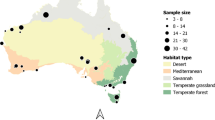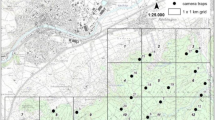Abstract
The alternative prey hypothesis (APH) states that when the density of the main prey declines, generalist predators switch to alternative prey and vice versa, meaning that predation pressure on the alternative prey should be negatively correlated with the density of the main prey. We tested the APH in a system comprising one generalist predator (pine marten, Martes martes), cyclic main prey (microtine voles, Microtus agrestis and Myodes glareolus) and alternative prey (cavity nests of common goldeneye, Bucephala clangula); pine marten is an important predator of both voles and common goldeneye nests. Specifically, we studied whether annual predation rate of real common goldeneye nests and experimental nests is negatively associated with fluctuation in the density of voles in four study areas in southern Finland in 2000–2011. Both vole density and nest predation rate varied considerably between years in all study areas. However, we did not find support for the hypothesis that vole dynamics indirectly affects predation rate of cavity nests in the way predicted by the APH. On the contrary, the probability of predation increased with vole spring abundance for both real and experimental nests. Furthermore, a crash in vole abundance from previous autumn to spring did not increase the probability of predation of real nests, although it increased that of experimental nests. We suggest that learned predation by pine marten individuals, coupled with efficient search image for cavities, overrides possible indirect positive effects of high vole density on the alternative prey in our study system.



Similar content being viewed by others
References
Ackerman JT (2002) Of mice and mallards: positive indirect effects of coexisting prey on waterfowl nest success. Oikos 99:469–480
Andreassen HP, Glorvigen P, Rémy A, Ims RA (2013) New views on how population-intrinsic and community-extrinsic processes interact during vole population cycles. Oikos 122:507–515
Angelstam P, Lindström E, Widén P (1984) Role of predation in short-term population fluctuations of some birds and mammals in Fennoscandia. Oecologia 62:199–208
Angelstam P, Lindström E, Widén P (1985) Synchronous short-term population fluctuations of some birds and mammals in Fennoscandia—occurrence and distribution. Holarc Ecol 8:285–298
Barraquand F, New LF, Redpath S, Matthiopoulos J (2015) Indirect effects of primary prey population dynamics on alternative prey. Theor Popul Biol 103:44–59
Brainerd SM, Helldin J-O, Lindström ER, Rolstad E, Rolstad J, Storch I (1995) Pine marten (Martes martes) selection of resting and denning sites in Scandinavian managed forests. Ann Zool Fenn 32:151–157
Brommer JE, Pietiäinen H, Ahola K, Karell P, Karstinen T, Kolunen H (2010) The return of the vole cycle in southern Finland refutes the generality of the loss of cycles through ‘climate forcing’. Glob Chang Biol 16:577–586
Brook RW, Pasitschniak-Arts M, Howerter DW, Messier F (2008) Influence of rodent abundance on nesting success of prairie waterfowl. Can J Zool 86:497–506
Burnham KP, Anderson DR (2002) Model selection and multimodel inference: a practical information-theoretic approach, 2nd edn. Springer, New York
Caryl FM, Raynor R, Quine CP, Park KJ (2012) The seasonal diet of British pine marten determined from genetically identified scats. J Zool 288:252–259
Cornulier T, Yoccoz NG, Bretagnolle V, Brommer JE, Butet A, Ecke F, Elston DA, Framstad E, Henttonen H, Hörnfeldt B, Huitu O, Imholt C, Ims RA, Jacob J, Jędrzejewska B, Millon A, Petty SJ, Pietiäinen H, Tkadlec E, Zub K, Lambin X (2013) Europe-wide dampening of population cycles in keystone herbivores. Science 340:63–66
Dow H, Fredga S (1983) Breeding and natal dispersal of the goldeneye, Bucephala clangula. J Anim Ecol 52:681–695
Dunn E (1977) Predation by weasels (Mustela nivalis) on breeding tits (Parus spp.) in relation to the density of tits and rodents. J Anim Ecol 46:633–652
Elmberg J, Pöysä H (2011) Is the risk of nest predation heterospecifically density-dependent in precocial species belonging to different nesting guilds? Can J Zool 89:1164–1171
Fredga S, Dow H (1984) Factors affecting the size of a local population of goldeneye Bucephala clangula (L.) breeding in Sweden. Viltrevy 13:225–251
Graham IM, Lambin X (2002) The impact of weasel predation on cyclic field-vole survival: the specialist predator hypothesis contradicted. J Anim Ecol 71:946–956
Hanski I, Henttonen H, Korpimäki E, Oksanen L, Turchin P (2001) Small-rodent dynamics and predation. Ecology 82:1505–1520
Hansson L, Henttonen H (1985) Gradients in density variations of small rodents: the importance of latitude and snow cover. Oecologia 67:394–402
Helldin JO (1999) Diet, body condition, and reproduction of Eurasian pine martens Martes martes during cycles in microtine density. Ecography 22:324–336
Helldin JO (2000) Seasonal diet of pine marten Martes martes in southern boreal Sweden. Acta Theriol 45:409–420
Holt RD (1977) Predation, apparent competition, and the structure of prey communities. Theor Popul Biol 12:197–229
Holt RD, Lawton JH (1994) The ecological consequences of shared enemies. Annu Rev Ecol Syst 25:495–520
Hörnfeldt B, Hipkiss T, Eklund U (2005) Fading out of vole and predator cycles? Proc R Soc B 272:2045–2049
Huitu O, Kiljunen N, Korpimäki E, Koskela E, Mappes T, Pietiäinen H, Pöysä H, Henttonen H (2009) Density-dependent vole damage in silviculture and associated economic losses at a nationwide scale. For Ecol Manag 258:1219–1224
Ims RA, Henden JA, Killengreen ST (2008) Collapsing population cycles. Trends Ecol Evol 23:79–86
Ims RA, Henden JA, Thingnes AV, Killengreen ST (2013) Indirect food web interactions mediated by predator–rodent dynamics: relative roles of lemmings and voles. Biol Lett 9:20130802
Ježková M, Svobodová J, Kreisinger J (2014) Dynamics of rodent abundance and ground-nest predation risks in forest habitats of Central Europe: no evidence for the alternative prey hypothesis. Folia Zool 63:269–280
Korpela K, Delgado M, Henttonen H, Korpimäki E, Koskela E, Ovaskainen O, Pietiäinen H, Sundell J, Yoccoz NG, Huitu O (2013) Nonlinear effects of climate on boreal rodent dynamics: mild winters do not negate high-amplitude cycles. Glob Chang Biol 19:697–710
Korpela K, Helle P, Henttonen H, Korpimäki E, Koskela E, Ovaskainen O, Pietiäinen H, Sundell J, Valkama J, Huitu O (2014) Predator–vole interactions in northern Europe: the role of small mustelids revised. Proc R Soc B 281:20142119
Korpimäki E, Klemola T, Norrdahl K, Oksanen L, Oksanen T, Banks PB, Batzli GO, Henttonen H (2003) Vole cycles and predation. Trends Ecol Evol 18:494–495
Korpimäki E, Oksanen L, Oksanen T, Klemola T, Norrdahl K, Banks PB (2005) Vole cycles and predation in temperate and boreal areas. J Anim Ecol 74:1150–1159
Lack D (1954) The natural regulation of animal numbers. Oxford University Press, London
Lanszki J, Zalewski A, Horváth G (2007) Comparison of red fox Vulpes vulpes and pine marten Martes martes food habita in a deciduous forest in Hungary. Wildl Biol 13:258–271
Lewis KP (2004) How important is the statistical approach for analyzing categorical data? A critique using artificial nests. Oikos 104:305–315
Marcström V, Kenward RE, Engren E (1988) The impact of predation on boreal tetraonids during vole cycles: an experimental study. J Anim Ecol 57:859–872
Marcström V, Keith LB, Engren E, Cary JR (1989) Demographic responses of arctic hares (Lepus timidus) to experimental reductions of red foxes (Vulpes vulpes) and martens (Martes martes). Can J Zool 67:658–668
McKinnon L, Berteaux D, Bêty J (2014) Predator-mediated interactions between lemmings and shorebirds: a test of the alternative prey hypothesis. Auk 131:619–628
Nilsson SG, Johnsson K, Tjernberg M (1991) Is avoidance of black woodpeckers of old nest holes due to predators? Anim Behav 41:439–441
Oli MK (2003) Population cycles of small rodents are caused by specialist predators: or are they? Trends Ecol Evol 18:105–107
Paasivaara A, Pöysä H (2008) Habitat-patch occupancy in the common goldeneye (Bucephala clangula) at different stages of the breeding cycle: implications to ecological processes in patchy environments. Can J Zool 86:744–755
Pelech SA, Smith JNM, Boutin S (2010) A predator’s perspective of nest predation: predation by red squirrels is learned, not incidental. Oikos 119:841–851
Pöysä H (1999) Conspecific nest parasitism is associated with inequality in nest predation risk in the common goldeneye (Bucephala clangula). Behav Ecol 10:533–540
Pöysä H (2003) Parasitic common goldeneye (Bucephala clangula) females lay preferentially in safe neighbourhoods. Behav Ecol Sociobiol 54:30–35
Pöysä H (2006) Public information and conspecific nest parasitism in goldeneyes: targeting safe nests by parasites. Behav Ecol 17:459–465
Pöysä H, Pöysä S (2002) Nest-site limitation and density dependence of reproductive output in the common goldeneye Bucephala clangula: implications for the management of cavity-nesting birds. J Appl Ecol 39:502–510
Pöysä H, Milonoff M, Virtanen J (1997) Nest predation in hole-nesting birds in relation to habitat edge: an experiment. Ecography 20:329–335
Pulliainen E, Ollinmäki P (1996) A long-term study of the winter food niche of the pine marten Martes martes in northern boreal Finland. Acta Theriol 41:337–352
R Development Core Team (2011) R: a language and environment for statistical computing. Vienna (Austria): R Foundation for Statistical Computing. http://www.R-project.org/. Accessed 31 May 2016
Ringelman KM (2014) Predator foraging behavior and patterns of avian nest success: what can we learn from an agent-based model? Ecol Model 272:141–149
Schielzeth H (2010) Simple means to improve the interpretability of regression coefficients. Methods Ecol Evol 1:103–113
Schmidt KA, Ostfeld RS (2008) Numerical and behavioral effects within a pulse-driven system: consequences for shared prey. Ecology 89:635–646
Schmidt KA, Whelan CJ (1998) Predator-mediated interactions between and within guilds of nesting songbirds: experimental and observational evidence. Am Nat 152:393–402
Sonerud GA (1985) Nest hole shift in Tengmalm’s owl Aegolius funeresus as defence against nest predation involving long-term memory in the predator. J Anim Ecol 54:179–192
Sorace A, Petrassi F, Consiglio C (2004) Long-distance relocation of nestboxes reduces nest predation by Pine Marten Martes martes. Bird Study 51:119–124
Stenseth NC (1999) Population cycles in voles and lemmings: density dependence and phase dependence in a stochastic world. Oikos 87:427–461
Sundell J, O’Hara RB, Helle P, Hellstedt P, Henttonen H, Pietiäinen H (2013) Numerical response of small mustelids to vole abundance: delayed or not? Oikos 122:1112–1120
Turchin P, Hanski I (1997) An empirically based model for latitudinal gradient in vole population dynamics. Am Nat 149:842–874
Van Leeuwen E, Jansen VAA, Bright PW (2007) How population dynamics shape the functional response in a one-predator–two-prey system. Ecology 88:1571–1581
Zalewski A (1997) Patterns of resting site use by pine marten Martes martes in Białowieża National Park (Poland). Acta Theriol 42:153–168
Zalewski A, Jędrzejewski W (2006) Spatial organization and dynamics of the pine marten Martes martes population in Biaƚowieża Forest (E Poland) compared with other European woodlands. Ecography 29:31–43
Zárybnická M, Riegert J, Kouba M (2015) Indirect food web interactions affect predation of Tengmalm’s owls Aegolius funereus nests by pine martens Martes martes according to the alternative prey hypothesis. Ibis 157:459–467
Zhou YB, Newman C, Xu WT, Buesching CD, Zalewski A, Kaneko Y, Macdonald DW, Xie ZQ (2011) Biogeographical variation in the diet of Holarctic martens (genus Martes, Mammalia: Carnivora: Mustelidae): adaptive foraging in generalists. J Biogeogr 38:137–147
Zub K, Jędrzejewska B, Jędrzejewski W, Bartoń KA (2012) Cyclic voles and shrews and non-cyclic mice in a marginal grassland within European temperate forest. Acta Theriol 57:205–216
Acknowledgments
We thank T. Hoogesteger, H. Koivunen, R. Koivunen and P. Timonen for doing vole trapping and P. Timonen for doing the field work with common goldeneye nesting and nest predation experiments in Lammi, Padasjoki and Mäntyharju. Insightful comments from an anonymous reviewer greatly improved the manuscript.
Author contribution statement
HP originally formulated the idea, KJ and HP compiled the data, HP and AP analysed the data, HP wrote the manuscript with contributions from KJ and AP.
Author information
Authors and Affiliations
Corresponding author
Additional information
Communicated by Christopher Whelan.
Electronic supplementary material
Below is the link to the electronic supplementary material.
Rights and permissions
About this article
Cite this article
Pöysä, H., Jalava, K. & Paasivaara, A. Generalist predator, cyclic voles and cavity nests: testing the alternative prey hypothesis. Oecologia 182, 1083–1093 (2016). https://doi.org/10.1007/s00442-016-3728-9
Received:
Accepted:
Published:
Issue Date:
DOI: https://doi.org/10.1007/s00442-016-3728-9




